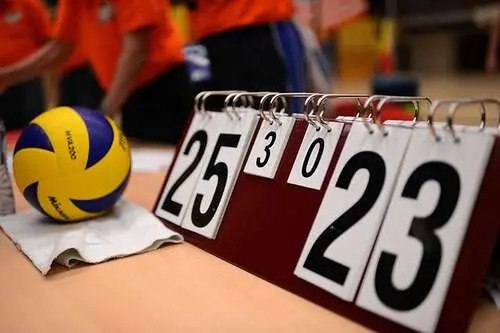Volleyball Scoring System

Volleyball Scoring System: An In Depth Guide
Volleyball is a dynamic and thrilling sport played and enjoyed worldwide. The excitement of the game largely hinges on its unique scoring systems. Understanding these systems is essential for players, coaches and fans alike, as it affects gameplay strategy, pacing and match outcomes.
Over the years, the sport has utilized two primary scoring methods: rally scoring and side out scoring. This article explores both systems, their histories and their impact on modern volleyball.
The Basics of Volleyball Scoring
A volleyball match is played between two teams, each consisting of six players on the court. The objective is to send the ball over the net and into the opponent’s court in a way that they cannot return it. A point is awarded when a team successfully lands the ball in the opposing team’s court, or if the opposing team makes an error.
To win a match, a team must win a predetermined number of sets (typically three out of five in professional play, or two out of three in recreational play). Each set is won by the team that first reaches 25 points with at least a 2 point lead. However, if a match reaches a deciding fifth set, that set is usually played to 15 points instead of 25, while still requiring a 2 point lead to win.
Key Scoring Terms
- Set: A segment of the match where teams compete to reach a set point total (usually 25 or 15 points).
- Match: The overall contest between the two teams, consisting of multiple sets.
- Serve: The action that starts a rally by sending the ball over the net.
- Rally: The sequence of play that begins with a serve and ends when a point is scored.
- Side out: When the serving team loses the rally and the serve goes to the opposing team.
Now that we understand the basics, let’s dive into the two main scoring methods.
Rally Scoring System
What is Rally Scoring?
Rally scoring is the current standard scoring system used in most competitive volleyball matches, including international tournaments like the Olympics and domestic leagues. In rally scoring, a point is awarded on every rally, regardless of which team serves. This system was adopted to make the game faster, more exciting and easier for spectators to follow.
How Rally Scoring Works
- A rally begins when the server serves the ball.
- A point is awarded to the team that wins the rally, either by landing the ball in the opponent’s court or by causing the opponent to make an error (e.g., hitting the ball out of bounds, committing a net violation, or failing to return the ball in three hits).
- If the serving team wins the rally, they score a point and continue serving.
- If the receiving team wins the rally, they score a point and gain the right to serve (this is known as a “side out”).
Advantages of Rally Scoring
- Faster Matches: Since a point is awarded after every rally, sets tend to be shorter and more predictable in duration.
- Excitement for Fans: The continuous point scoring keeps the action dynamic and engaging for spectators.
- Fairer System: Both teams have an equal opportunity to score points, making it a balanced system.
- Ease of Understanding: For new fans, rally scoring is more straightforward to follow compared to older scoring methods.
Common Rally Scoring Rules
- A set is typically played to 25 points, but a team must win by at least 2 points.
- In the case of a deciding fifth set, the set is played to 15 points.
- There are no point caps, meaning a set can extend beyond 25 or 15 points until one team gains a 2 point lead.
Rally scoring has now become the universally accepted format across all levels of volleyball, from youth leagues to professional competitions.
Side Out Scoring System
What is Side Out Scoring?
Side out scoring was the original scoring system used in volleyball before rally scoring was introduced. Under this system, only the serving team can score points. If the receiving team wins a rally, they do not earn a point; instead, they gain the right to serve (a “side out”).
How Side Out Scoring Works
- The serving team starts the rally by serving the ball.
- If the serving team wins the rally, they score a point and continue serving.
- If the receiving team wins the rally, they do not score a point but gain the serve (a side out).
- The rally continues until one team reaches a predetermined point total (usually 15 points).
Advantages of Side Out Scoring
- Longer Matches: Because only the serving team can score points, matches can be longer and allow for greater comebacks.
- Strategic Play: Emphasis is placed on serving skill and defensive play, as points are harder to come by.
- Traditional Appeal: Some players and coaches appreciate the strategic depth and pacing of side out scoring.
Disadvantages of Side Out Scoring
- Unpredictable Match Length: Matches could last much longer than anticipated, making scheduling difficult for tournaments and broadcasters.
- Slower Pace: The potential for long stretches without points can make matches less exciting for spectators.
- Difficult for Newcomers: The scoring system can be confusing for new fans who expect constant action.
History of Side Out Scoring
Side out scoring was used in volleyball from the sport’s inception in 1895 until the early 2000s. The shift to rally scoring was officially adopted by the Fédération Internationale de Volleyball (FIVB) in 1999 for international competitions. The change was intended to make the game more spectator friendly and manageable for television broadcasts.
The Transition to Rally Scoring
The transition from side out scoring to rally scoring was met with both excitement and resistance. Traditionalists who appreciated the tactical nuances of side out scoring were hesitant to embrace the change.
However, the benefits of rally scoring, including faster matches, greater consistency and improved audience engagement. Ultimately led to its widespread adoption.
Impact on Gameplay
- Increased Pressure on Serves: In rally scoring, every serve can lead to a point for either team, putting more emphasis on accurate and strategic serving.
- Consistency in Match Length: Rally scoring ensures that matches are of a predictable length, making it easier for organizers and broadcasters to plan events.
- Faster Decision Making: Teams must adapt quickly to each play, as the potential to score points is constant.
Conclusion
Understanding the volleyball scoring system is crucial for anyone who plays, coaches, or enjoys the sport. The transition from side out scoring to rally scoring marked a significant evolution in the game. While side out scoring emphasized patience and defensive skill, rally scoring has modernized volleyball by making it faster, fairer and more engaging for fans worldwide.
Whether you’re watching a beach volleyball match or a professional indoor tournament, recognizing the nuances of rally scoring will enhance your appreciation of the sport. As volleyball continues to grow in popularity, the rally scoring system ensures that the game remains exciting, accessible and dynamic for all participants and viewers.


